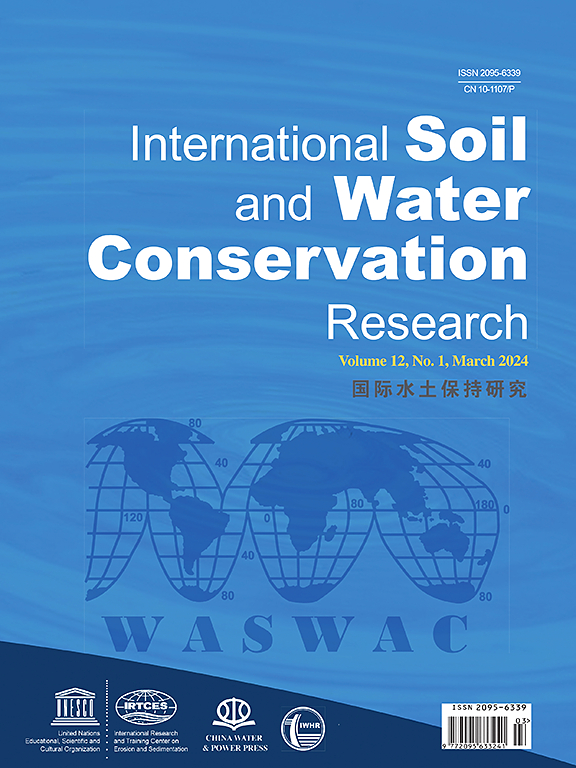Spatiotemporal detailed crop cover and management factor maps as agri-environmental indicators for soil erosion in Germany
IF 7.3
1区 农林科学
Q1 ENVIRONMENTAL SCIENCES
International Soil and Water Conservation Research
Pub Date : 2025-06-07
DOI:10.1016/j.iswcr.2025.06.002
引用次数: 0
Abstract
The crop cover and management factor (C factor) is crucial to assess the impact of management on soil erosion by water within the (R)USLE (Revised Universal Soil Loss Equation) modelling framework. Its derivation is challenging due to the need for spatiotemporal data on crop sequences. Therefore, the aim of this study is the generation of spatiotemporal detailed C factor datasets for Germany by integrating (a) crop composition data from agricultural statistics on the municipality level for six individual years from 1999 to 2020 and (b) high-resolution (10 × 10 m) crop sequence information for 2017 to 2023 derived from earth observation data in the C factor estimation. The results reveal an overall increase of 8.7 % in the mean C factor for German municipalities from 1999 to 2020, which can be attributed to policy-driven changes in crop composition. The comparison of the two C factor datasets emphasises the importance of multi-annual information on crops in (R)USLE-based erosion modelling as (i) high-resolution C factors based on single years show a weak agreement with crop sequence-derived C factors (RMSE of 0.062) and (ii) C factors based on crop composition data from agricultural statistics are 5.7 % lower compared to high-resolution crop sequence-derived C factors. As high-resolution crop type data from earth observation is updated yearly, the C factor maps presented here can be incorporated into German monitoring systems as agri-environmental indicators. Further research is needed to obtain more detailed information on cover crops and tillage practices to improve C factor derivation. These findings and the visible heterogenious patterns in the pixel-based multi-annual C factor data highlight that spatiotemporal high-resolution input data is key in C factor estimation.
作为德国土壤侵蚀农业环境指标的时空详细作物覆盖和管理因子图
在(R)USLE(修正通用土壤流失方程)模型框架中,作物覆盖和管理因子(C因子)对于评估管理对水土流失的影响至关重要。由于需要作物序列的时空数据,其推导具有挑战性。因此,本研究的目的是通过整合(a) 1999 - 2020年6年市级农业统计的作物组成数据和(b) C因子估算中来自地球观测数据的2017 - 2023年高分辨率(10 × 10 m)作物序列信息,生成德国的时空详细C因子数据集。结果显示,从1999年到2020年,德国市政当局的平均C系数总体增加了8.7%,这可归因于政策驱动的作物组成变化。两个C因子数据集的比较强调了(R) usle侵蚀模型中作物多年信息的重要性,因为(i)基于单年的高分辨率C因子与作物序列衍生的C因子(RMSE为0.062)的一致性较弱,(ii)基于农业统计数据的作物组成数据的C因子比高分辨率作物序列衍生的C因子低5.7%。由于来自地球观测的高分辨率作物类型数据每年都会更新,因此这里展示的C因子图可以作为农业环境指标纳入德国监测系统。需要进一步的研究来获得更详细的覆盖作物和耕作方法的信息,以改善C因子的推导。这些发现以及基于像素的多年C因子数据中可见的异质性模式突出表明,时空高分辨率输入数据是估算C因子的关键。
本文章由计算机程序翻译,如有差异,请以英文原文为准。
求助全文
约1分钟内获得全文
求助全文
来源期刊

International Soil and Water Conservation Research
Agricultural and Biological Sciences-Agronomy and Crop Science
CiteScore
12.00
自引率
3.10%
发文量
171
审稿时长
49 days
期刊介绍:
The International Soil and Water Conservation Research (ISWCR), the official journal of World Association of Soil and Water Conservation (WASWAC) http://www.waswac.org, is a multidisciplinary journal of soil and water conservation research, practice, policy, and perspectives. It aims to disseminate new knowledge and promote the practice of soil and water conservation.
The scope of International Soil and Water Conservation Research includes research, strategies, and technologies for prediction, prevention, and protection of soil and water resources. It deals with identification, characterization, and modeling; dynamic monitoring and evaluation; assessment and management of conservation practice and creation and implementation of quality standards.
Examples of appropriate topical areas include (but are not limited to):
• Conservation models, tools, and technologies
• Conservation agricultural
• Soil health resources, indicators, assessment, and management
• Land degradation
• Sustainable development
• Soil erosion and its control
• Soil erosion processes
• Water resources assessment and management
• Watershed management
• Soil erosion models
• Literature review on topics related soil and water conservation research
 求助内容:
求助内容: 应助结果提醒方式:
应助结果提醒方式:


